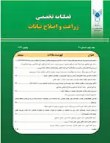Effects of salinity stress on membrane stability, chlorophyll Content and yield components of wheat inoculated with plant growth promoting bacteria and humic acid
Author(s):
Abstract:
Salinity is one of the main obstacles to the production of crops in dry regions of the world Crop yield to the influence of the different methods. Reduction in leaf area as the effect of salinity, Potential for plant photosynthesis hash will work. Similarly, degradation of chlorophyll by the toxic ions from including sodium, photosynthesis would decrease, and humic acid, as an organic acid obtained from humus and organic sources without any environmental destructive effects and Plant growth promoting bacteria through the effects of hormonal and nutrient improve uptake to raise grain yield in wheat, especially in terms of salinity can be effective. For this purpose an experiment was conducted in 2010 at research greenhouse, Faculty of Agriculture and plant breeding, Islamic Azad University of Karaj Branch. A completely randomized design with three replications was using analysis of factorial. experimental treatments included two levels of humic acid: (A0): control, (A1): humic acid consumption, and salinity levels in the three levels of: (B0): control, (B1): Low salinity of 75 mM, (B2): high salinity of 150 mM, the use of microorganisms in the five levels of: (C0): control, (C1): grain inoculation with Azospirillum lipoferum, (C2): grain inoculation with Azotobacter chroocccum, (C3): Grain inoculation with Pseudomonase putida, (C4): the mix grain inoculation with (Azotobacter chroocccum, Azospirillum lipoferum, Pseudomonase putida).The results showed the effect of grain inoculation with plant growth promoting bacteria and humic acid consumption during exercise salinity on Grain yield, Biologic yield, Number of spiklet and chlorophyll a, b Content was significant. The highest grain yield of treatments inoculated with Azetobacter chroocccum bacteria and humic acid no consumption and the salinity was 75 mM, and Most of biologic yield of treatments with Pseudomonase putida and humic acid consumption and the salinity was 75 mM. And Most of the number of spikelets per plant of treatments inoculated with the mix grain inoculation and humic acid consumption and no salinity stress. While the highest chlorophyll a, b Content of treatments with Azospirillum lipoferum and humic acid consumption and salt stress of 75 mM was.
Keywords:
Language:
Persian
Published:
Journal of Agronomy and Plant Breeding, Volume:8 Issue: 2, 2012
Page:
71
magiran.com/p1084366
دانلود و مطالعه متن این مقاله با یکی از روشهای زیر امکان پذیر است:
اشتراک شخصی
با عضویت و پرداخت آنلاین حق اشتراک یکساله به مبلغ 1,390,000ريال میتوانید 70 عنوان مطلب دانلود کنید!
اشتراک سازمانی
به کتابخانه دانشگاه یا محل کار خود پیشنهاد کنید تا اشتراک سازمانی این پایگاه را برای دسترسی نامحدود همه کاربران به متن مطالب تهیه نمایند!
توجه!
- حق عضویت دریافتی صرف حمایت از نشریات عضو و نگهداری، تکمیل و توسعه مگیران میشود.
- پرداخت حق اشتراک و دانلود مقالات اجازه بازنشر آن در سایر رسانههای چاپی و دیجیتال را به کاربر نمیدهد.
In order to view content subscription is required
Personal subscription
Subscribe magiran.com for 70 € euros via PayPal and download 70 articles during a year.
Organization subscription
Please contact us to subscribe your university or library for unlimited access!


